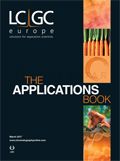SFC or (U)HPLC? Why Not Try Both...
The Application Notebook
Projects in drug discovery and safety constantly aim at development of novel and safer drugs, therapeutics, and diagnostics. During active pharmaceutical ingredient (API) development, drug stereoisomerism is recognized as an issue having clinical and regulatory implications. Enantiomers have essentially identical physical and chemical properties, while potentially showing large differences in toxicity.
G.J. Schad1, Y. Watabe2, and H. Terada2, 1Shimadzu Europa GmbH, 2Shimadzu Corporation
Projects in drug discovery and safety constantly aim at development of novel and safer drugs, therapeutics, and diagnostics. During active pharmaceutical ingredient (API) development, drug stereoisomerism is recognized as an issue having clinical and regulatory implications. Enantiomers have essentially identical physical and chemical properties, while potentially showing large differences in toxicity.
Stereoisomeric composition of a drug with a chiral centre should therefore be well documented. To evaluate the pharmacokinetics of a single enantiomer or any mixture of enantiomers, manufacturers must develop quantitative assays for individual enantiomers early in drug development.
One of the challenges of chiral separations is the fact that enantiomers exhibit the same physical and chemical properties, so they can only be separated in a chiral environment. For chromatographic separations chiral stationary phases are available that enable the separation of stereoisomers. However, to determine the stationary phase that offers optimum selectivity for the chiral separation problem at hand, screening runs are usually performed, testing several chiral columns at a time. Normal-phase high performance liquid chromatography (HPLC) is often the method of choice but supercritical fluid chromatography (SFC) has frequently been proven to be a superior method for the separation of chiral compounds. This application note shows an example of the method scouting for two established chiral compounds (Figure 1) using HPLC as well as SFC. Each technique has its advantages, and running the two approaches with one instrument in a single overnight sequence was easily achieved using an LC/SFC switching system, resulting in the optimum separation method for each compound.
Figure 1: Structure and chiral centre of (a) omeprazole and (b) warfarin.

Method Development
For UHPLC and SFC method scouting a Shimadzu Nexera UC LC/SFC switching system with Method Scouting Solution was used (Figure 2), consisting of a CO2 pump (LC-30ADSF), two quaternary solvent pumps (LC-30AD), an autosampler (SILâ30AC), two column ovens (CTO-20AC) including six column switching valves (FCVâ34AH), and a backpressure regulator (SFC-30A). The system was also equipped with an SPDâM20A photo diode array detector with high pressure resistant flow cell.
Figure 2: Schematic of Nexera UC LC/SFC switching system.

The stationary phases used for chiral screening for the separation of stereoisomers of warfarin and omeprazole, as well as mobile phases and separation conditions are displayed in Tables 1 and 2.


Results
A total of 36 different chromatographic conditions were evaluated in a single sequence. The dedicated Method Scouting Solution Software was used to generate screening methods and batch files automatically according to pre-set templates, to avoid human error. Ideal separation and detection conditions for each compound were determined in one overnight run. Figures 3 and 4 show the screening results for warfarin and omeprazole. It can be seen that while SFC clearly offers better separation of the warfarin isomers, omeprazole is better separated using HPLC conditions.
Figure 3: Screening results for separation of warfarin isomers.

Figure 4: Screening results for separation of omeprazole isomers.

Conclusion
The Nexera UC LC/SFC switching system in combination with the Method Scouting Solution software is the ideal tool for quick and efficient development of reliable and fast chiral separation methods in (U)HPLC or SFC mode with a single instrument.

Shimadzu Europa GmbH
Albert-Hahn-Str. 6–10, D-47269 Duisburg, Germany
Tel. +49 203 76 87 0 Fax +49 203 76 66 25
E-Mail: shimadzu@shimadzu.eu
Website: www.shimadzu.eu
Determining the Effects of ‘Quantitative Marinating’ on Crayfish Meat with HS-GC-IMS
April 30th 2025A novel method called quantitative marinating (QM) was developed to reduce industrial waste during the processing of crayfish meat, with the taste, flavor, and aroma of crayfish meat processed by various techniques investigated. Headspace-gas chromatography-ion mobility spectrometry (HS-GC-IMS) was used to determine volatile compounds of meat examined.
University of Tasmania Researchers Explore Haloacetic Acid Determiniation in Water with capLC–MS
April 29th 2025Haloacetic acid detection has become important when analyzing drinking and swimming pool water. University of Tasmania researchers have begun applying capillary liquid chromatography as a means of detecting these substances.
Using GC-MS to Measure Improvement Efforts to TNT-Contaminated Soil
April 29th 2025Researchers developing a plant microbial consortium that can repair in-situ high concentration TNT (1434 mg/kg) contaminated soil, as well as overcome the limitations of previous studies that only focused on simulated pollution, used untargeted metabolone gas chromatography-mass spectrometry (GC-MS) to measure their success.

.png&w=3840&q=75)

.png&w=3840&q=75)



.png&w=3840&q=75)



.png&w=3840&q=75)











